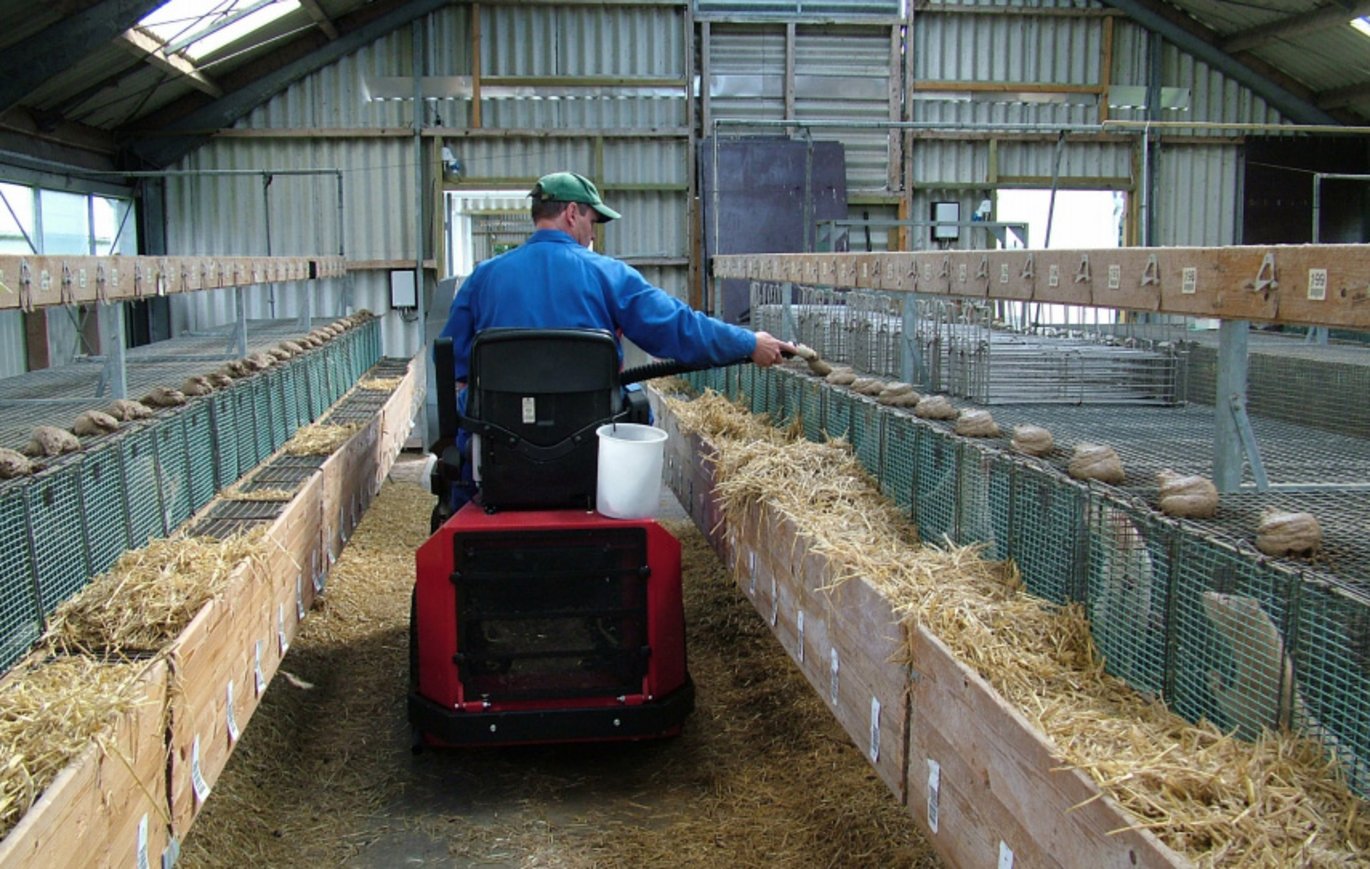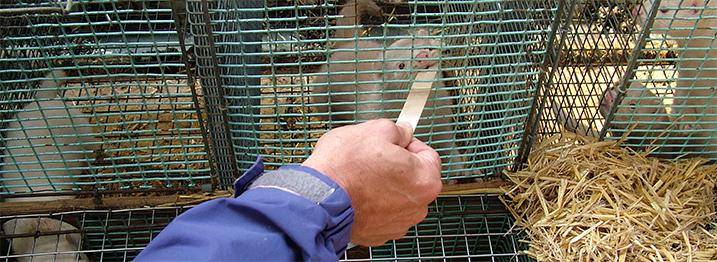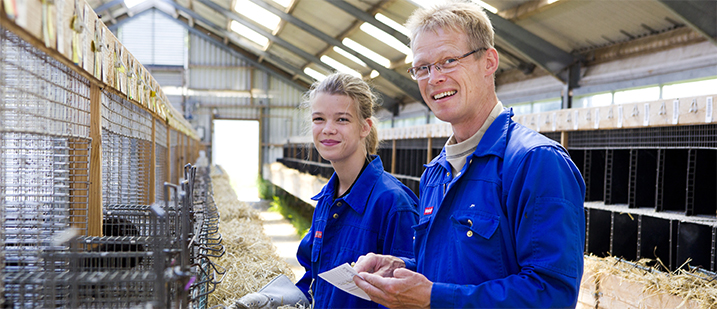The WelFur protocol is now available for all European fur breeders
From January 2017, fur animal welfare assessment according to the WelFur protocol will be available for all European fur breeders. The WelFur protocols were developed by scientists from Department of Animal Science, Aarhus University together with five other countries.

In 2009 the European Fur Breeders’ Association initiated the “WelFur” project with the purpose of developing a welfare assessment protocol for mink and fox farms, following the standards developed within the framework of the EU Welfare Quality® project. The assessment is based on four welfare principles: “Good feeding”, “Good housing”, “Good health” and ”Appropriate behaviour” including 12 underlying criteria and 22 welfare measurements -to be measured on-farm in three different seasons. WelFur mink has been tested in 12 countries and based on this the protocol is adjusted and optimized. Research efforts focus on the optimization of WelFur without reducing the quality. Electronic data collection gathering ensures that breeders are informed of the results immediately following the assessment. Like other production data these results may be used for production planning purposes in consultation with advisors and veterinarians.
Development of WelFur protocol for mink
The WelFur protocols for welfare assessment in mink and fox farms were developed by scientists from six countries in the period from 2009 to 2014, and are based on the Welfare Quality® concept (Møller et al., 2015). The entire process was supervised by a group of highly recognized scientists, including the Welfare Quality® project manager, in order to ensure that fur animal welfare was assessed according to the same principles and standards as applied for other production animals.
Welfare assessments include registrations from three different seasons in a production year – (season 1: Adult breeders during the winter period; Season 2: Adults and kits in the reproduction period; Season 3: Adults and juveniles in the growth period) – to cover the entire life cycle of mink and to achieve a comprehensive assessment of the welfare within the production system.
During each season the animals are exposed to major changes, and health challenges vary within the seasons. In order to reduce this variation the three WelFur observation periods are limited to last from 6 to 8 weeks. The observation periods are as follows:
1. Breeding animals in January-February;
2. Suckling period in May-June, and
3: Growth period from late September and until pelting

Individual mink farm welfare is assessed according to 22 welfare parameters, covering the 12 welfare criteria that constitute the four welfare principles of Welfare Quality® (Table 1). Measurements are animal-based as far as possible; i.e. they are used to measure animal behaviour or health. If this it is not possible, resource-based measurements are applied instead; i.e. registration of housing systems or management routines.
The measurements have been selected based on an examination of previous research and from thorough discussions between scientists within the area. All measurements have been assessed in relation to validity (do the measurements reflect mink welfare), reliability (are measurements replicable – within and between observers) and feasibility (can they be applied in practice and at reasonable costs). Assessment of animal-based and resource-based measurements is based on a representative sample of animals on the farm, and the welfare of the sample animals is considered as an estimate for the entire farm. A representative sample consists of 120 cages (20 sections of 6 cages each) during the winter and suckling periods; and 90 cages (15 sections of 6 cages each) during the growth period.

Going from measurements to a complete assessment
The final welfare assessment at farm-level is based on the calculation of several welfare scores from the on-farm registrations. The assessment is a stepwise weighted sum of scores between the levels; i.e. from 22 measurements 12 criteria 4 principles 1 overall assessment. This weighted sum is based on an expert panel assessment of the welfare measurements and their importance to animal welfare during various periods as well as the Welfare Quality ® guidelines regarding the extent to which good welfare in one area may compensate for poor welfare in another area.
In practice, the weighted sum is achieved by calculating a score between 0 and 100 (100 being the best achievable and 50 a neutral value indicating welfare that is neither good nor poor) for each of the 12 criteria based on on-farm registrations. Next, these 12 scores are combined to produce a value between 0 and 100 for each of the 4 principles and this will eventually result in a classification within one of the four welfare categories. The categories and threshold values have been defined as follows: Best current practice (animal welfare score at highest level with values ranging from 80-100), Good current practice (animal welfare scores ranging from 55-80), Acceptable current practice (animal welfare score is above or equal to minimum requirements ranging from 20-55) and Unacceptable current practice (animal welfare score is low and considered unacceptable).
The categories are not based on average scores for each principle. Thus, a high score in relation to one principle will only to a lesser extent compensate for a very low score in relation to other principles. A farm is classified in the category “Best current practice” if it scores more than 55 on all principles and more than 80 on two of them. Likewise, a farm is considered to correspond to “Good current practice” if it scores more than 20 on all principles and more than 55 on two of them. A farm in the category “Acceptable current practice” scores more than 10 on all principles and more than 20 on three principles. Farms that do not achieve these scores are considered to correspond to “Unacceptable current practice”.

Welfare categories and scoresIn practice, the weighted sum is achieved by calculating a score between 0 and 100 (100 being the best achievable and 50 a neutral value indicating welfare that is neither good nor poor) for each of the 12 criteria based on on-farm registrations. Next, these 12 scores are combined to produce a value between 0 and 100 for each of the 4 principles and this will eventually result in a classification within one of the four welfare categories. The categories and threshold values have been defined as follows:
- Best current practice (animal welfare score at highest level with values ranging from 80-100),
- Good current practice (animal welfare scores ranging from 55-80),
- Acceptable current practice (animal welfare score is above or equal to minimum requirements ranging from 20-55) and
- Unacceptable current practice (animal welfare score is low and considered unacceptable).
The categories are not based on average scores for each principle. Thus, a high score in relation to one principle will only to a lesser extent compensate for a very low score in relation to other principles. A farm is classified in the category “Best current practice” if it scores more than 55 on all principles and more than 80 on two of them. Likewise, a farm is considered to correspond to “Good current practice” if it scores more than 20 on all principles and more than 55 on two of them. A farm in the category “Acceptable current practice” scores more than 10 on all principles and more than 20 on three principles. Farms that do not achieve these scores are considered to correspond to “Unacceptable current practice”.
Research and testing
in 2015-16 the WelFur protocol was tested in 27 mink farms in 10 European countries in order to test the assessment under different climatic conditions and at farms in countries with different mink production traditions. Among other results, these tests demonstrated certain challenges in relation to achieving the necessary information from the breeders, e.g. in relation to representative samples.
Therefore, a new method has been developed, allowing samples to be taken without previous information. The WelFur assessments were feasible in all countries; however, in relation to some test procedures certain challenges existed, e.g. cage design. Based on experiences from various tests the WelFur assessment protocol has beenoptimized.

Perspectives
The major part of the tested farms was placed in the category “Good current practice”, some in the “Best current practice” category and a few in “Acceptable current practice” category. Thus, WelFur is able to distinguish between animal welfare levels in different farms. However, there may be significant variation in the scores – in relation to the 4 principles, 12 criteria and 22 measurements – between farms allocated to the same category. This means that there is a huge difference between the areas that the individual farms should work with in order to achieve a higher score or be allocated to a better category at the next assessment. It is, therefore, very important for the farmers to know if they should increase focus on e.g. mortality rates or animal temperament.
In order for the individual farmer to know why his farm was allocated to a certain assessment category, he should be given access to the details of the welfare assessment after the visit. A tablet solution for on-farm recording of WelFur registrations has been developed and allows the farmer to receive a copy of the results immediately after the assessment. The sections observed as part of the WelFur assessment are marked with yellow plastic cards allowing the farmer to see for himself whether the cages observed gave rise to comments. This ensures complete transparency as to the basis of the assessment.
Once the final results for the farm in question are available, the individual farmer can consider which production areas should be in focus and also – in cooperation with his advisor – establish goals and plan efforts in order to achieve the goals. Thus, the WelFur assessment results will become part of the farm management together with – and interacting with – all other types of information used by fur breeders to take care of their animals in the best possible way.
You can read the full article from the annual thematic meeting on current mink research at Aarhus University, held at research center Foulum on 20 September 2016 here.
More information
Steen H. Møller, Department of Animal Science, Aarhus University
E-mail: steenh.moller@anis.au.dk
Anna F. Marsbøll, Department of Animal Science, Aarhus University
E-mail: anna.marsboll@anis.au.dk
Britt I. F. Henriksen, Department of Animal Science, Aarhus University
E-mail: britt.henriksen@anis.au.dk
